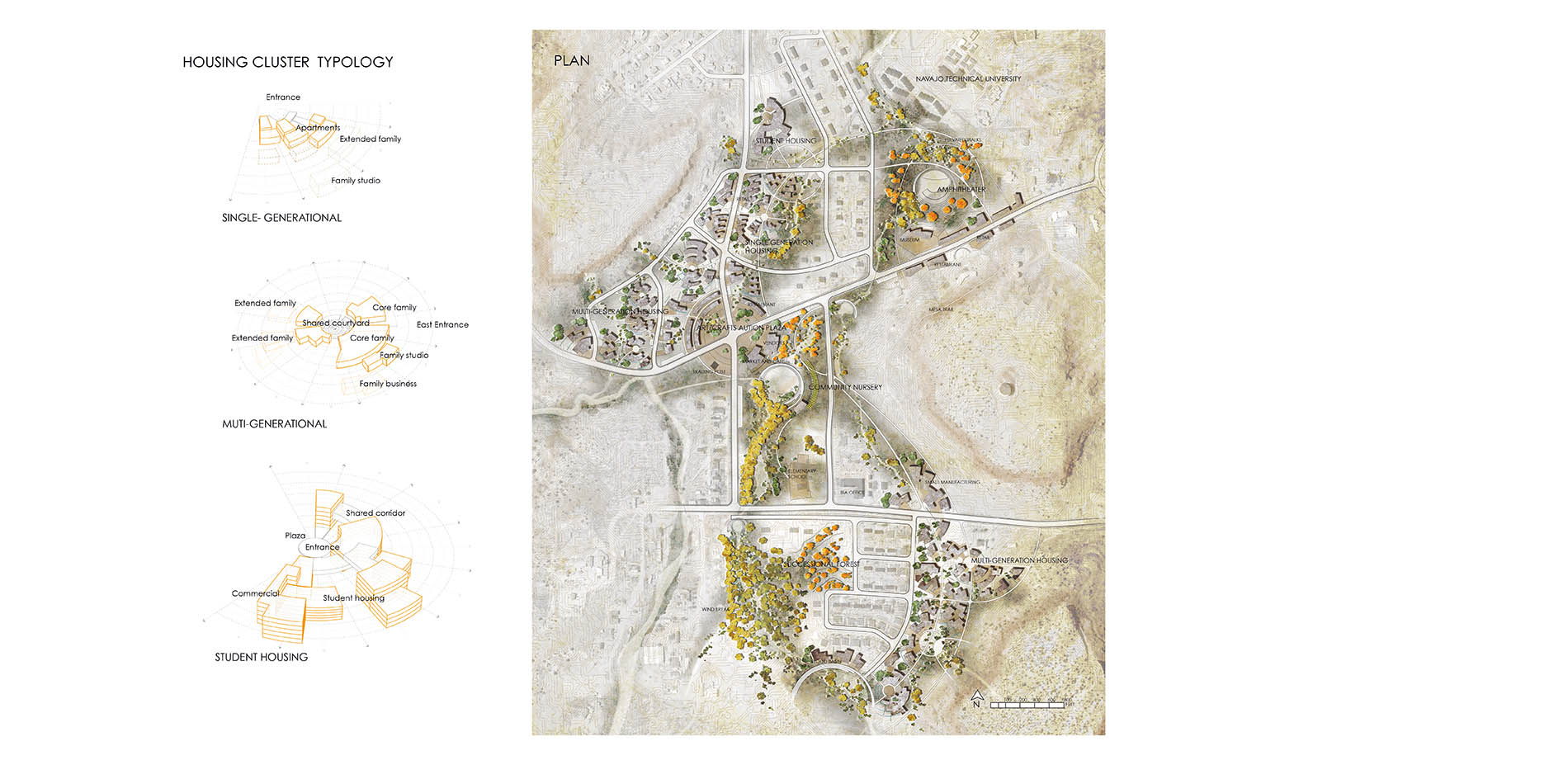
Plan
The housing strategy includes three housing cluster types: single-generational, multi-generational and student housing. The housing clusters are designed in a circular grid, allowing units to expand as families grow.
Photo Credit: Diana Gruberg, Assoc. ASLA and Chunlan Zeng, Student ASLA
Media: Please submit high-resolution image requests to images@asla.org.
Planting and Grading Plan
When the Navajo first came to the Crownpoint area they called it T'iis ts'ooz nideeshgiizh, meaning “narrow trees in the canyon.” Our planting scheme aims to restore the benefits of living in a seasonally flooded arroyo, envisioning a cycle between families, the community, and the earth.
Photo Credit: Diana Gruberg, Assoc. ASLA and Chunlan Zeng, Student ASLA
Media: Please submit high-resolution image requests to images@asla.org.
Housing Cluster Site Plan
Housing units are clustered around shared central courtyards inspired by the traditional Hogan. An amphitheater for events and performances is situated between the university and a new museum for Navajo culture.
Photo Credit: Diana Gruberg, Assoc. ASLA and Chunlan Zeng, Student ASLA
Media: Please submit high-resolution image requests to images@asla.org.
Housing Cluster Grading and Planting Plan
Local drainage is managed within the housing clusters. Central common space in each cluster includes a sunken plaza for gatherings and seasonal flood control, a planting scheme that filters grey water from the houses, and a set of vertical hydroponic gardens.
Photo Credit: Diana Gruberg, Assoc. ASLA and Chunlan Zeng, Student ASLA
Media: Please submit high-resolution image requests to images@asla.org.
Existing Conditions
The design addresses three major existing conditions on site: fragmented development, soils+ elevation, and drainage + flooding.
Photo Credit: Diana Gruberg, Assoc. ASLA and Chunlan Zeng, Student ASLA
Media: Please submit high-resolution image requests to images@asla.org.
Mitigating Flash Flooding
In the southwest, major seasonal shifts affect water availability and climate. The flood mitigation strategy includes 5 detention basins that slow the flow velocity of water during heavy rains, with capacity for the 25-year, 24-hour storm. An emergency spillway is in place for the 100-year storm.
Photo Credit: Diana Gruberg, Assoc. ASLA and Chunlan Zeng, Student ASLA
Media: Please submit high-resolution image requests to images@asla.org.
Pilot Study: Fog Catchers
Fog collection is optimized in high altitude areas where a shift in diurnal temperature from the cold of the night to the warmth of the day causes condensation of atmospheric vapor. Our test site includes a shelter constructed of local willow poles and an array of fog catchers. A polypropelene mesh is affixed perpendicular to moisture-heavy prevailing winds, directing condensed fog into a cistern below.
Photo Credit: Diana Gruberg, Assoc. ASLA and Chunlan Zeng, Student ASLA
Media: Please submit high-resolution image requests to images@asla.org.
Multi-Generation Housing Cluster Plan
Multi-generation buildings contain core family houses with extended families aggregated around them.
Photo Credit: Diana Gruberg, Assoc. ASLA and Chunlan Zeng, Student ASLA
Media: Please submit high-resolution image requests to images@asla.org.
Multi-Generation Housing Cluster Section
The buildings are arrayed under a tiered roof structure outfitted with biochar for grey water filtration.
Photo Credit: Diana Gruberg, Assoc. ASLA and Chunlan Zeng, Student ASLA
Media: Please submit high-resolution image requests to images@asla.org.
Single-Generation Housing Cluster Plan and Section
Single-generation housing areas are designed for young couples and scholars who work at the university. The threshold of inside and outside space allow for interchange between family and community.
Photo Credit: Diana Gruberg, Assoc. ASLA and Chunlan Zeng, Student ASLA
Media: Please submit high-resolution image requests to images@asla.org.
Housing Exterior View
Units are designed to meet seamlessly with the outdoor plaza and family studio spaces. The hydroponic farm structures delineate private and public space while allowing light to pass through. Attached to the clusters, family businesses allow folks to earn a livelihood and connect with the community at large.
Photo Credit: Diana Gruberg, Assoc. ASLA and Chunlan Zeng, Student ASLA
Media: Please submit high-resolution image requests to images@asla.org.
Community Nursery Plan
Centrally located between the university and the elementary school, the community nursery enhances the local economy and meets the restoration needs of Crownpoint. Plants grown here are used in community plantings, employed as material for crafts, and sold to visitors from neighboring towns.
Photo Credit: Diana Gruberg, Assoc. ASLA and Chunlan Zeng, Student ASLA
Media: Please submit high-resolution image requests to images@asla.org.
Dam Section
The basins are constructed of soil cement, a cheap construction material that combines local soil with Portland cement and water. They are designed to emerge from the existing landscape, as stepped terraces negotiate the grade change between the holding area and adjacent plantings.
Photo Credit: Diana Gruberg, Assoc. ASLA and Chunlan Zeng, Student ASLA
Media: Please submit high-resolution image requests to images@asla.org.
Basin Section
A basin just north of the elementary school is the centerpiece for multiple programs. A café and market with back yard terrace negotiates the grade of the dam, allowing people to congregate above the arroyo.
Photo Credit: Diana Gruberg, Assoc. ASLA and Chunlan Zeng, Student ASLA
Media: Please submit high-resolution image requests to images@asla.org.
Between Fog and Flood: Nursery View
The community hoop house is clad in a fog catcher mesh that harvests potable water and stores it in a cistern below. A separate cistern holds excess storm water after seasonal flood, for use in irrigation.
Photo Credit: Diana Gruberg, Assoc. ASLA and Chunlan Zeng, Student ASLA
Media: Please submit high-resolution image requests to images@asla.org.


















